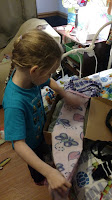There are 5 requirements to earning the Brownie "Pets" badge.
They are:
1. Find out what care different pets need.
2. Keep a pet comfy.
3. Help a pet stay healthy and safe.
4. Make a pet feel loved.
5. Feed a pet.
1. Find out what care different pets need: Play bingo at a pet store.
We went to our local pet store, where Maya chatted with staff (including a former Girl Scout!) and learned about the animals the store had, how to take care of them, what they eat, and what animal would be a good fit for our family. Maya found out about dogs, hamsters, bunnies, fish, cats, and birds. (And now, she is desperate to add a dog to our family!)
2. Keep a pet comfy: make a cozy sleeping space for a pet.
Maya read through her pet book and then using our pretend (stuffed animal) dog, she made a doggie bed using towels, blankets, and a box, and then made a chew/play toy out of one of her dad's old shirts.
3. Help a pet stay healthy and safe: all three (adapted).
Maya created a pamphlet on how to keep dogs healthy (choice 1), how dogs get exercise (choice 2), and how to keep dogs looking good (step 3). She had to go to the library to get information about the options and then, over the course of a week, read about dog care and needs, and worked on her trifold brochure.
4. Make a pet feel loved: Learn about how three different kinds of pets communicate their feelings.
We did a take on this. Instead of finding out about three different pets, Maya was really interested in learning about PPD in dogs. The dog she fell in love with at the pet store had postpartum depression. Maya had heard this phrase before, because I've suffered with PPD, mildly with her younger brother and to a greater extent with her youngest brother, and she wanted to know all about it in dogs. (This dog had even another check mark because she and I share birthdays.)
So, we came home from the store and researched PPD in dogs and we found out several things. Like humans, dogs lose interest in food, may sleep excessively, and may not bond with their puppies (which may be a precursor or promote PPD since the puppies may be taken away). Some dogs may completely ignore their puppies or "overmother" them. As we read this, Maya was sad; she wanted to bring home Arcadia even more. But she was happy to hear that there is treatment for PPD in dogs. (Of course, part of how Maya wants to treat her, is to adopt her!)
5. Feed a pet: Make a pet budget for two pets for a month.
We decided to make a monthly pet budget for a fish and a dog. Maya was blown away by how expensive it is. This was her list of needs for the month.
Dog: water, food, dog biscuits, vitamins, one toy per month, shampoo/soap, flea/tick collar
Dog: Water: Free (from the tap at home)
Dog Food: $48 for 30lb bag times 1 bag/month = $48
Dog Biscuits: $8 for 20oz times 1 bag/month = $8
Dog Treats: $6 for 10oz times 2 bags/month = $12
Dog Vitamins:$9 for a bottle times 1 bottle/month = $9
Dog Toy: $8
Dog Soap/Shampoo: $17/ bottle times 1 bottle/month = $17
Dog Flea/Tick Collar: $40 (but lasts for 8 months so 2 per year $80 divided by 12 months) = $7
Total: $109
Beta Fish: water, food
Beta Fish Water: $4/gal times 4 gal/month = $16
Beta Food: $2/ bottle times 1 bottle/month = $2
Total: $18/month
BEYOND THE BADGE:
We explored animals that are wild but can be domesticated, such as chickens, goats, sheep, ponies, reptiles, and birds at the Elmwood Park Zoo. The kids talked about different ways that life in the wild would differ from life in a home.
Note: By far, this was the most difficult badge for us thus far. We don't have pets and, at this point, don't foresee having any in the near future. Nor do we have regular access to pets. This badge required a bit of adaptation and some thinking outside of the box.















No comments:
Post a Comment